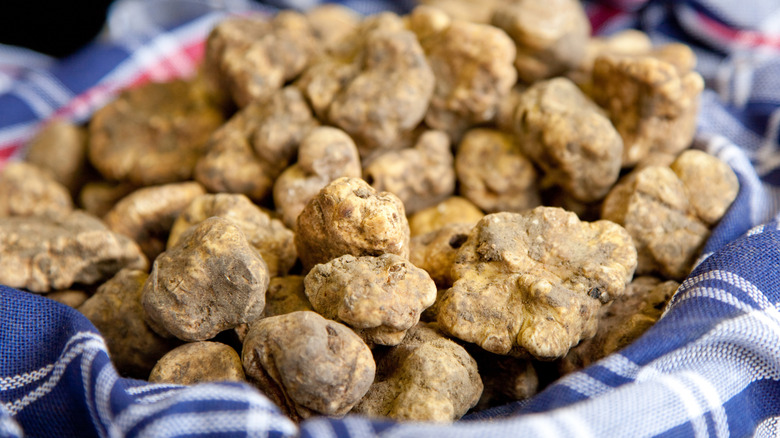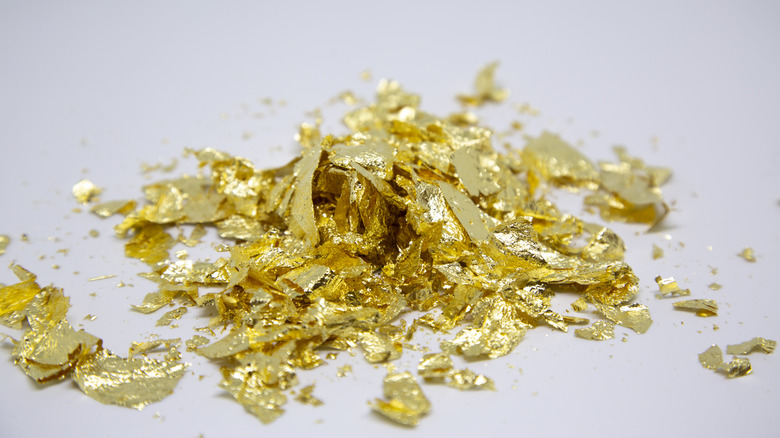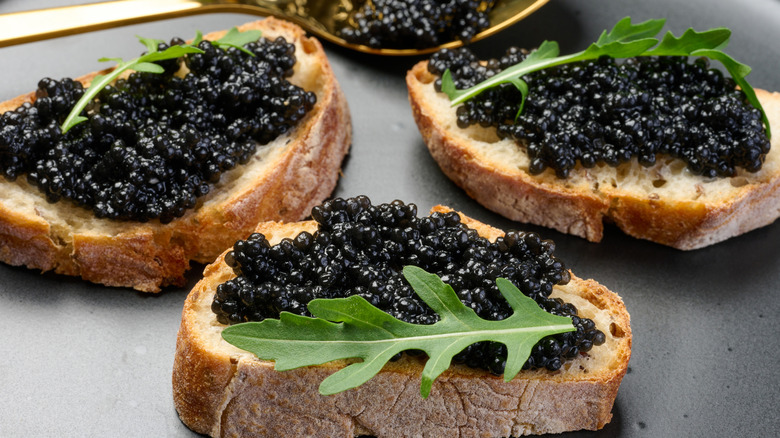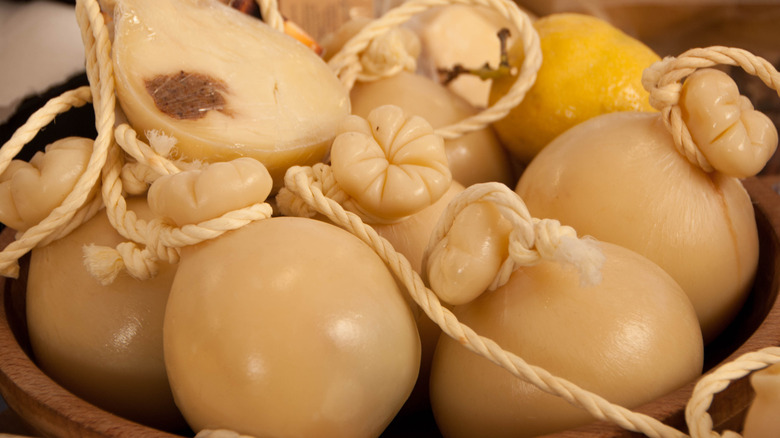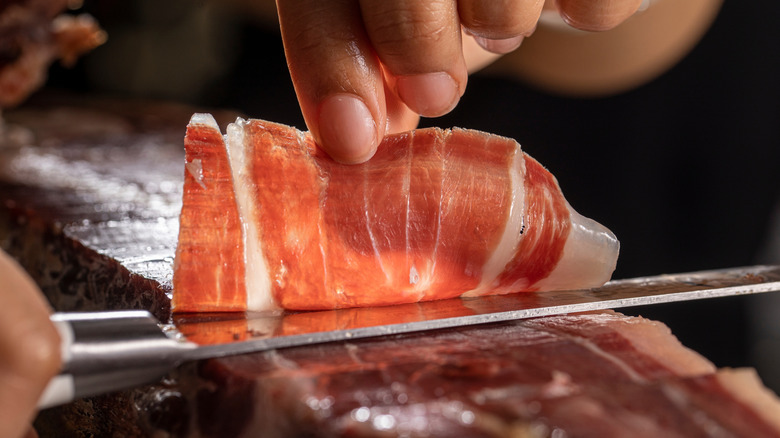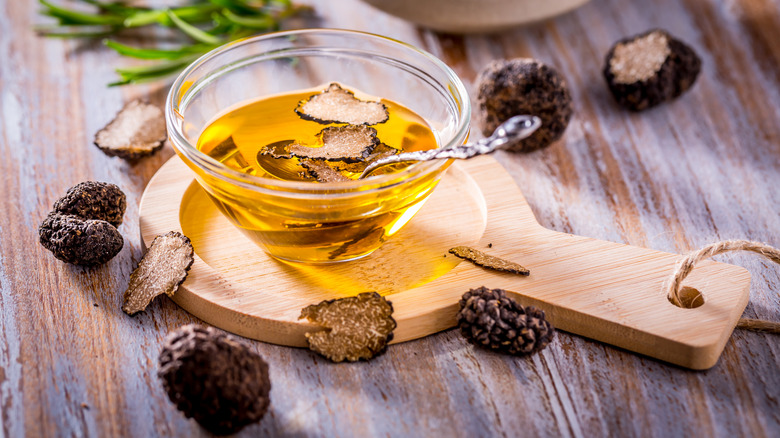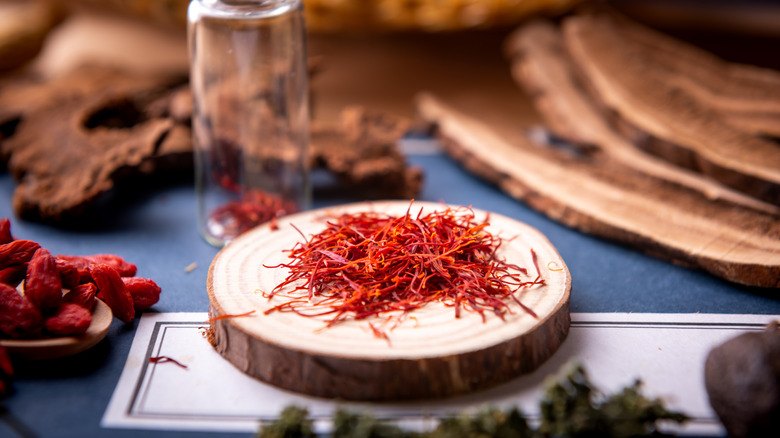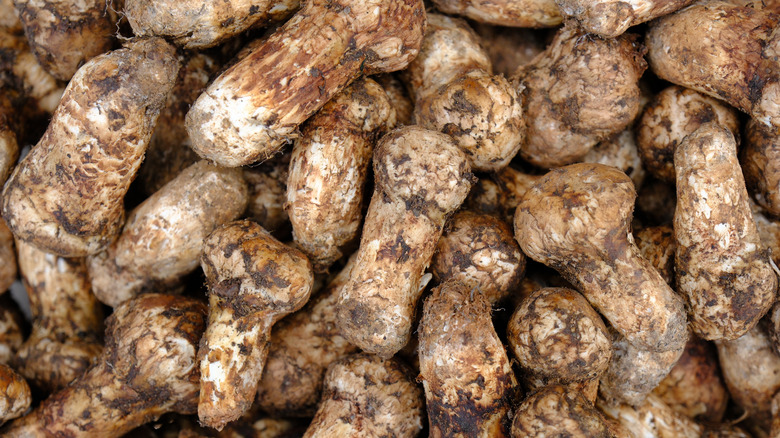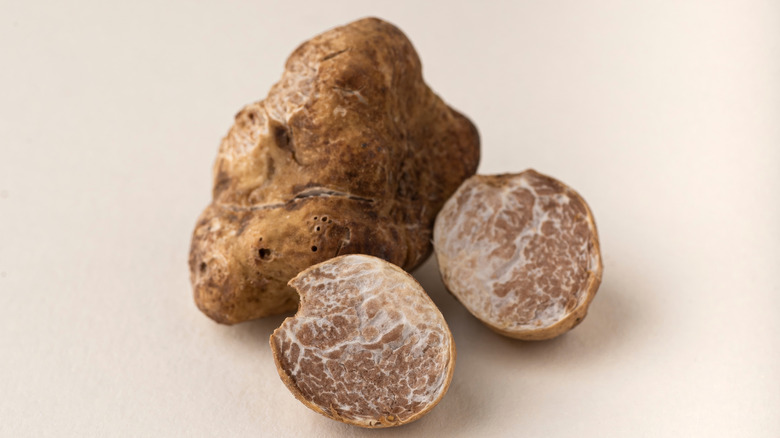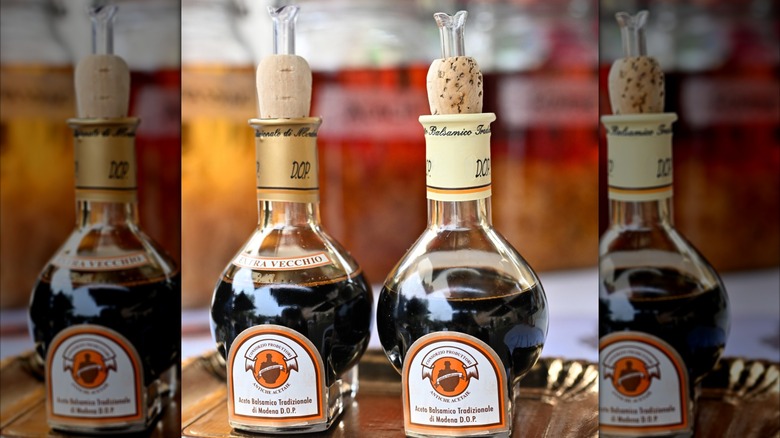Gourmet Ingredients That Aren't Worth The Price
Although we all want to make meals using the best, most gourmet foods we can find, the fact is that many of those ingredients are extremely expensive. The combination of the increased cost of living and the ongoing rise of tariffs has caused food prices to continue climbing, with the cost of food at home rising by 2.2% and food away from home by almost 4% in the 12-month period ending in July 2025 (per the U.S. Bureau of Labor Statistics). These higher prices have caused a lot of people to question whether all of those fancy ingredients that food blogs recommend you buy are actually worth it.
Well, the truth is that a lot of them aren't. Some of the most fabled ingredients out there, like saffron, white truffle, and aged balsamic vinegar, have cheaper alternatives that offer a similar effect at a fraction of the cost. Other ingredients, like caviar and bluefin tuna, feel overly indulgent in a world that's increasingly concerned about sustainability. Perhaps worst of all are those ingredients that add nothing to your food, but which still cost the earth to buy. Let's dig into the gourmet ingredients you absolutely don't need.
Gold leaf
When it comes to food, gold leaf is perhaps the ultimate status symbol. We tend to think of edible gold as a relatively recent invention, one born from the excesses of the 20th century and a desire to make meals ever more gaudy, but it's actually been around for thousands of years. Gold was consumed in ancient China due to belief in its medicinal properties, and it was in medieval Europe that it became the marker of luxury that it remains today. As the years went on, the fascination with eating gold persisted, and nowadays it adorns burgers, fries, and ice creams in restaurants all over the world. Oh, and these eateries charge a pretty penny for the privilege of eating it.
Here's the thing, though: Edible gold has no function, apart from making the person eating it look gimmicky. It's tasteless both in terms of its cultural impact and in terms of its literal flavor. It doesn't contribute much on a texture level either, instead just providing your food with a light covering of film or flakes that melt to nothing. Sure, it can give some foods a visual pop, but beyond that it's not worth the money.
Caviar
Aren't we past caviar by now? Unfortunately, we know that we aren't: The food is still highly popular in fancy restaurants and steakhouses across the globe. However, we're here to make the case for skipping it, or at least replacing it with more reasonably priced and ethically sound options. Caviar, and particularly black caviar, justifies its high price by its rarity and the time it takes to produce it. It has to be farmed from fish kept in aquaculture (caviar from wild fish has been banned for years due to overfishing concerns), which is a lengthy and costly process.
While the caviar industry has made strides toward eco-friendliness, there are still question marks around the true sustainability and ethics of producing it, due to unscrupulous farming habits. Plus, it's hard to justify the wild price point of caviar, with some varieties costing $182 per ounce, when there are cheaper alternatives with a similar function and flavor. Salmon caviar is an affordable option with a bright red color, while lumpfish roe can give you the same black tone at a fraction of the price. For folks more concerned about appearance than flavor, you can skip the real stuff and try imitation caviar; soy pearls look just like caviar and are made without harming any fish.
Caciocavallo podolico
We love a good cheese as much as the next person, but there's a limit to how much we'll pay. Unfortunately, we're unlikely to stretch to the price of caciocavallo podolico. We can understand why this cheese, which tends to sell for around $50 per pound on specialty food websites, is so expensive. Caciocavallo podolico is produced from the milk of Podolica cattle, which yield lower amounts of liquid but with higher quality. The cheese is then hand-crafted and aged for up to 15 months, developing a complex, nutty flavor and compelling scent.
Now, that all sounds very nice, but can you justify dropping $50 on a cheese? We personally can't, especially when there are alternatives that give you a similar flavor for far less. Caciocavallo podolico can be substituted with provolone in most situations without a huge difference. You'll lose some of the spiciness caciocavallo has, but opting for an aged provolone helps fill in the flavor. Cheese connoisseurs may find the prospect of swapping caciocavallo podolico out for something else pretty jarring, but for the vast majority of us, it's just not worth the money.
Iberico ham
There's ham, and then there's Iberico ham. This cured meat is well-known as one of the most exclusive ham products out there, due to its tightly controlled production process that results in a rich, intense flavor. Iberico ham is made from Iberian pigs, which have a unique ability to store fat between their muscles. This gives the ham a particularly full and buttery taste, augmented by the pigs' diet of acorns. The ham is then cured and dried for years, intensifying its flavor to an almost absurd degree.
Unfortunately, all of these factors contribute to Iberico ham's astonishingly high price. Some varieties can cost up to around $1,400 per 2.2 pounds, and while it might be a once-in-a-lifetime ingredient to try, for everyday use it's just not worth the cost. Serrano ham, by contrast, offers a more affordable alternative. The difference between Iberico and serrano ham is that the latter is made from regular pigs and aged for a shorter time. This gives it a less distinctive flavor, but it still packs a punch. Serrano ham still isn't cheap, but it's far easier on your finances.
Truffle oil
Few ingredients are as expensive, and as disappointing, as truffle oil. This concoction is touted as a way to create a pungent flavor in your food without paying the extortionate price of fresh truffles. However, it's a controversial ingredient that will likely never provide you with the authentic flavor of these fungi, and will instead cost you dearly for a pale imitation. Truffle oil is typically made with a synthetic version of the compound found in truffles that gives them their fragrance. This compound is then mixed with grapeseed or olive oil, bottled, and sold at a high price. There are versions of natural truffle oil, but these are cumbersome to make and generally rare.
So, while truffle oil might seem like an affordable way to experience truffles, it's actually a con. You'll end up paying high prices for a product lacking authenticity, which won't give you their true taste. Instead, you get an oil with an overpowering scent and no subtlety or complexity. If you want to know what truffles really taste like, you'll have to pay up for the real thing. Otherwise, we advise skipping it altogether and just using regular oil.
Saffron
Saffron is famously expensive, and it's not hard to see why. This spice is so pricey because it cannot be harvested industrially and instead must be picked by hand. The usable part comes from the stigmata of the saffron flower, and since there are only three in each plant, it's a slow and laborious process. The stigmata then have to be dried before they're ready for cooking.
The manual harvesting process, combined with saffron's ability to produce a lush, golden color in food, has led to its high price, further inflated by its reputation as an extravagant ingredient. Saffron can retail for up to $12 per gram in the United States, making it largely impractical for day-to-day cooking. Most of the time you can use turmeric to get a similar result. Turmeric has a slightly different flavor (it's more earthy, whereas saffron is delicate and fragrant), but it produces the vivid yellow color most of us crave.
Bluefin tuna
Bluefin tuna is one of the most contentious seafoods out there — and one of the most expensive too. The tuna has a famously high price, with one fish selling for approximately $1.76 million in Tokyo in 2013, and it's readily available in restaurants around the world and from fish merchants. Sadly, though, it's one of those seafoods that's simply too expensive to justify, particularly when you consider how ethically questionable it is. Bluefin tuna is incredibly delicious, but it's been subject to overfishing across much of the world, leading to depleted stocks and a vulnerable population.
When you combine that with the sheer cost of buying this fish — bluefin tuna's price has soared dramatically over the past several decades — is it any wonder it doesn't justify itself? Plus, it's important to consider that when you buy bluefin tuna, you feed into the industry that fishes it, preventing real ethical changes from taking hold. Luckily, you can still enjoy tuna without making a questionable and expensive choice. Yellowfin (ahi) tuna is an affordable alternative, while ono and albacore tuna are also great options.
Matsutake mushrooms
If you've ever heard people talk about matsutake mushrooms, it's likely been in hushed tones. These ultra-exclusive mushrooms are the jewel of the fungus world, and they can be even more expensive than the more famous black truffles. Matsutake mushrooms have an intense, spicy scent and flavor (some say they taste a little like cinnamon), and the short window in which they grow makes them a prized delicacy. In Japan, matsutake mushrooms can go for around the equivalent of $100 per 100 grams. That's a pretty pricey 'shroom, huh?
In our opinion, though, matsutake mushrooms just don't pack enough punch in most culinary situations to justify their expense. Sure, if you're having them prepared by a world-class chef as part of a once-in-a-lifetime meal, it might be worth splashing out. But if you're cooking at home, you can likely get away with using shiitake mushrooms instead. Shiitakes have a rich, woody flavor that provides a similar intensity, and while they don't have the same spiciness, they're far more affordable.
White truffle
It's no secret that white truffles are expensive — but of all the gourmet ingredients out there, this is one people tend to accept as a necessary evil for their flavor. The problem is that it's a very high cost indeed. White truffles can sell for thousands of dollars per pound — Cellato, a Tokyo-based company, sells a pricey white truffle ice cream for over $6,000 U.S. dollars — and it's hard to imagine a future where they get cheaper, given that they're incredibly difficult to cultivate and remain scarce.
There's also the fact that white truffles are highly perishable. They need to be consumed fresh, and you only have a couple of days before they lose their flavor. Unless you're eating the whole thing right away, you're essentially throwing money down the drain. Sure, white truffles have an extraordinary and unique taste, but it's hard to argue they're worth the price in all but the fanciest of situations. When you're cooking at home for yourself, we'd certainly recommend saving your money.
Aged balsamic vinegar
You can think of aged balsamic vinegar as balsamic's classier cousin. Unlike regular balsamic, which carries a tart acidity that overshadows many of its fruity notes, aged balsamic vinegar develops a deep sweetness that really shines. It also gains a pleasing thickness from the years-long aging process.
The problem, of course, is the price. Tiny bottles of aged balsamic vinegar can cost hundreds of dollars. If you're planning to smother it all over your salad, you'll be paying a hefty sum per meal. Instead, there's an easy-to-find alternative that costs just a few bucks: balsamic glaze. It has the sweetness and concentrated depth of aged balsamic, with a good thickness that makes it just as at home on savory dishes, like bacon-wrapped grilled peaches, as it is on sweeter fare, like strawberry waffles. While it's not nearly as complex as its aged counterpart, the glaze works perfectly for everyday cooking.
